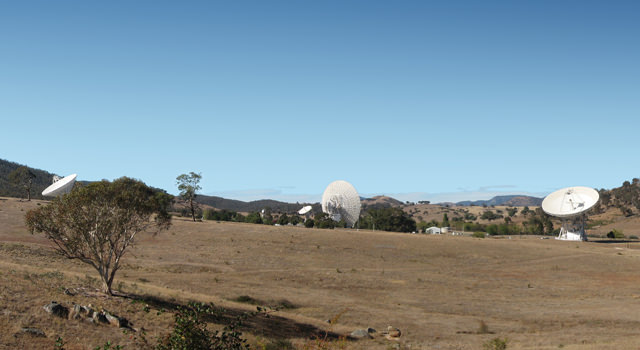[/caption]
All the robotic missions to various points in our solar system wouldn’t be possible if not for the Deep Space Network. It’s not just sending commands and receiving data, but also orbit determination, or keeping track of where the spacecraft are with radiometric tracking data so that spacecraft navigators can get probes exactly where the scientists want them to go. The three 70-meter antennas, located at the DSN complexes at Goldstone, California, Madrid, Spain, and Canberra, Australia are more than 40 years old and show wear and tear from constant use, while new and improved technology and antennas now available would improve operations. NASA announced this week they will begin to replace its aging fleet of dishes with a new generation of 34-meter (112-foot) antennas by 2025.
NASA broke ground this week by beginning to work on the facilities near Canberra, Australia. NASA expects to complete the building of up to three 34-meter antennas by 2018. The decision to begin construction came on the 50th anniversary of U.S. and Australian cooperation in space tracking operations.
“There is no better way to celebrate our 50 years of collaboration and partnership in exploring the heavens with the government of Australia than our renewed commitment and investment in new capabilities required for the next five decades,” said Badri Younes, deputy associate administrator for Space Communications and Navigation at NASA Headquarters in Washington.
The new antennas, known as “beam wave guide” antennas, can be used more flexibly, allowing the network to operate on several different frequency bands within the same antenna. Their electronic equipment is more accessible, making maintenance easier and less costly. The new antennas also can receive higher-frequency, wider-bandwidth signals known as the “Ka band.” This band, required for new NASA missions approved after 2009, allows the newer antennas to carry more data than the older ones.
Source: JPL


In Australia, NASA spends $A610 million ($US550 million) and locally employs 130 people, mostly at Tidbinbilla in Canberra. As such, Australia also spend australian taxpayers monies in supporting such endeavours. This is formally done though Space Sciences and Technology research through the CSIRO (Commonwealth Scientific and Industrial Research Organisation) I.e. CSIRO and NASA: four decades of collaboration
As given in this basis of the article, are the monies are mostly spent on this Deep Space Network – the ones giving information from interplanetary spacecraft across the Solar System – under the Space Vehicle Tracking and Communication Agreement; which was earlier under threat of the now imposed budgetary constraints by US bungling of its own economy.
Its seems the often irritating narrow view of some Americans that the US is absolutely sacrosanct and is unrelated to the rest of the world; is plainly wrong. (as Badri Younes points out.) If it were not for, in this instance, Spain and Australia and the agreements made with these countries, many results from your interplanetary spacecraft would never be received. (This may also explain why UT articles like these often receive few comments or general interest. Thank you Nancy for reporting on noteworthy events beyond the continental America!)
I believe when President Obama visits Australia in March 2010, he will be expressing commemoration of 70th anniversary of the US-Australia alliance and this 50 years of space cooperation. The story here is one of several announcements prior to his arrival. I look forward to these follow-up articles!
Note: Readers of UT might like to see further details at the Embassy Site of the United States. The No, 1 item is a picture of some politicians and the ambassador with shovels at the Canberra Deep Space Communication Complex. (I will be personally visiting this station at the 24th National Australian Convention of Amateur Astronomers (NACAA) over Easter 2010!)
Thanks for the extras, HSBC!
I, for one, hail our UT Overlords in their conquest of known web space.
Too bad we can’t hook up a bunch of old TV *.sat antenna’s and connect em together thru the internet somehow? cheaply? Resolution dependent upon how many people are ‘on line’?
Such an atypical response by American bloggers to this story.
If it ain’t in my borders it is not of interest.
Really. Narrow little minds deserve the open criticism – and the attitude as long as it goes my way or is in my sphere then “who gives a toss” – so it is very well deserved.
No wonder the attitude against Americans continue to all ends of the world. I.e. As parasitic invaders justifying their own delusional glory without the necessary acknowledging supporting external technologies nor the co-operation of others. So much cordial international relations – collectively most Americans just suck!
Before speaking about the attitude of Americans, one should look into the mirror… or perhaps re-read their own statements.
If anyone is being an arse… it is you SBC.
If you were so perfect, or perhaps not so inferior in your own mind as well as low with self-asteem; you wouldn’t have the need to berate.
Such a typical glib and moronic response by Aodhhan here.
Yet it just further proves my point Point out a significant attitudinal failure of the American psyche (mainly egocentricity) and in return all you get a personal attack.
Let’s see. Talk about positive co-operation between anywhere in the world and the US, but instead what you see and hear is the usual indifference.
Perhaps all the Australian people through its own legislators should just ask to remove the DSN altogether from its shores?
Would that be then more “perfect”?